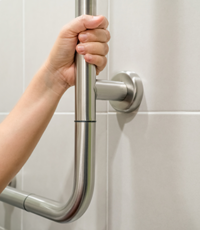
Many seniors are reaching the stage in their lives when they are choosing to downsize their homes for lifestyle or financial reasons. Other seniors are faced with a more difficult decision. Health and/or mobility concerns may require them to either retrofit their existing home to meet their changing needs, or to seek a more accommodating home.
The decision can be difficult because many simply don’t want to move. In such cases, especially if mobility challenges are arising, wheelchair accessibility may be necessary, not just at the home’s entrance, but under counters, in bathrooms, and through doorways as well. Ramps, elevators and stair-lifts may also need to be considered.
In addition, other small changes may need to be contemplated, such as easy-to-find and easy-to-use switches, possibly with remote or hands-free applications, as well as levers for all door handles. The addition of keyless entrances, remote control security and 24/7 monitoring devices will help put many family members at ease. However, in cases where a retrofit is cost-prohibitive, the logical option may well be to seek a bungalow or well-appointed condo that can be more easily adapted.
